DG Systems
Bytemaster
System Cards
Keyboard
Printer A & B
Phideck
Disk Drives
Documentation
Software
Flyers
Magazine Ads
Mark-8 Minicomputer
Apple-1
MOS Kim-1
V C F
Imsai 8080
Kenbak-1
TV Typewriter
LSI ADM-3A
ASR-33
The Digital Group
My Collection
HP-01
Test Equipment
Model Rocketry
| |

|
|
| Digital Group Systems
The Digital Group was a Denver Colorado based company founded in August
of 1974 by Dr. Robert Suding and Dick Bemis to sell microcomputers
designed by Suding. DG computers were among the most advanced
microcomputer systems available at the time. They offered users a choice
of CPU's that enabled upgrading or swapping processors to run software
written for any of the four most popular processors available: The Zilog
Z80, The Intel 8080, the Motorola 6800, and the 6500 series from MOS
Technology. DG computers included video, cassette tape, and keyboard
interface standard with every system, as well as a simple operating system
on tape geared towards programmers. The Z80 and 8080 systems also included
several demonstration programs. Notably, The Digital Group Z80 was the
first computer to use the still very popular Z80 microprocessor chip.
Digital Group computers were designed to be more user friendly than
other computers available at the time. Loading software on an audio based
system was as simple as pressing play on a cassette tape player and then
the reset button on the system to load a selected application or operating
system. Disk system (Diskmon) or data tape system (Phimon) startup was as
simple as pressing the reset button, and requesting the desired
application by name with the keyboard.
The software applications available were numerous, and varied from
business applications to hobby and gaming. The popularity of the DG
platform was such that programmers were eager to write applications for
it, and the standardization of the hardware allowed for an immediate and
large potential customer base.
Popular until the very end, Digital Group failed in August of 1979 due
to management and parts supplier troubles, not a lack of customer interest
or product orders. Co-founder Dr. Robert Suding recalled that at the time
of the bankruptcy, DG had thousands of product information requests and
orders waiting to be filled.
System Details
This was the "Cadillac of computers". In 1975, when this
system was introduced, Altair system owners were flipping switches for
hours just to watch lights blink on the front panel of their systems.
Digital Group system owners were throwing a power switch and loading an
operating system in less than 20 seconds. The cassette interface, standard
with DG systems, loaded programs at 1100 baud. At the time, this was
nearly four times the speed possible with any other manufacturers tape
systems, and ten times faster than paper tape -- the only method available
at the time for loading Micro Soft BASIC onto the Altair system. Of
course, to even do that on an Altair, you had to buy a paper tape reader
and an interface. Usually an ASR-33
Teletype and an SIO card. ($$$) By contrast, Digital Group systems
included a video and cassette interface and a keyboard as standard
equipment with all of their systems.
The Digital Group was among the very first to offer computer users a
"warm boot". When switched on, a Digital Group system was
ready to load the operating system, prompted by the message "Read
6800 INITIALIZE cassette" (or similar processor specific message).
As the tape was read, the screen would fill with the HEX or OCTAL page
high address of the byte being loaded, testing the memory content for
correctly loaded data as each byte was saved. A basic Digital Group
system consisted of three boards: Interchangeable processor card with 256 bytes of ROM and 2k of static RAM memory on board,
video/cassette card, and I/O card. These cards fit into a large standard
or small mini-motherboard. The standard motherboard would accept up to
three memory cards and a total of up to four I/O cards. The mini had
room for only one memory card besides the other three required boards.
Both motherboards had a small prototyping area near the processor card,
and solder points for video out, cassette in/out, and power supply
connections. A low current power supply was offered at a modest price, and
the customer could choose from a variety of +5 volt high current
supplies. The cabinet was optional, and many DG owners chose to build
their own cabinets, or order them from another supplier.
As for an Altair style front panel card with blinking lights and
switches... if you just had to have one, schematics were included with
the documentation. These were used mostly for troubleshooting. The
Digital Group system was far too sophisticated to actually need
something like that in normal operation! Still, many hobbyist really
like the blinking lights, and even though the front panel added little
functionality, they did add geek glamour!
|
|
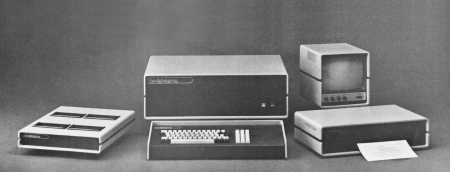
The Digital Group "System 4",
from Flyer #9, Circa 1977.
|
|
|
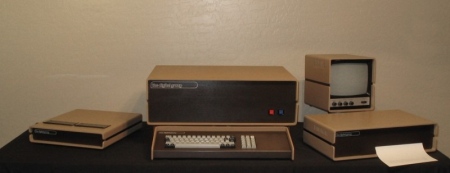
My Digital Group "System
4"
|
|
|
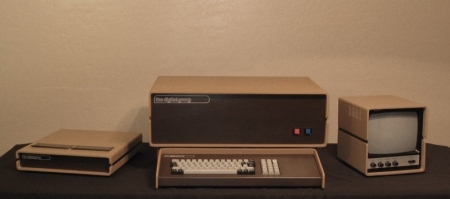
"System 3", as seen on the
cover of Flyer #8, 11/76
|
|
|
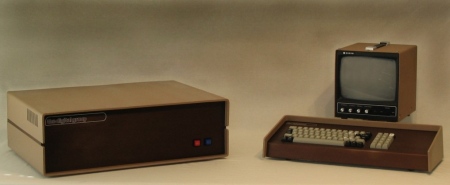
The original
|
|
|
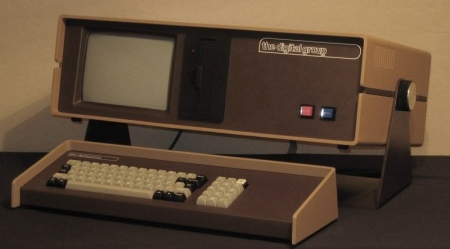
The Mini Bytemaster, the last DG system offered.
|
|
|
Digital Group also offered a very wide range of hardware accessories.
If it was available to computer users at the time, it was available to
DG system owners, and usually first. A users group of the time reported
(and I confirmed in conversation with Dr. Suding) that within two weeks
of the release of the Zilog Z80 chip samples, Dr. Suding had finalized
the design for the Digital Group Z80 processor card, and had working
systems on display at computer shows. Besting the closest competitor by
weeks if not months. Contrast that with the common practice of the day,
of running ads for a concept product, then using the money from the
customer orders to develop the advertised hardware.
Digital Group systems did not use the Altair S-100 buss
like so many other clones of the day. This is because dg systems were not
Altair clones, and were not inspired nor derived from Altairs. They were an
original design by Dr. Robert Suding, designed around the same time as the
Altair, but as history would have it, the Altair made it to market first.
|
|
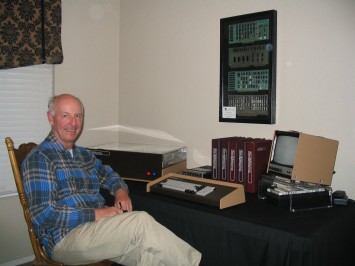
Dr Robert Suding, designer of all digital
group stuff, pays a visit to my collection.
|
|
|
Hardware Documentation I have several
detailed pages related to DG systems and hardware, as well as
documentation and and advertising -- Be sure to follow the links at
the top or left side of this page!
Digital Group Beginnings
The Digital Group was founded in 1974 shortly after Dr. Robert Suding saw the Mark-8
Minicomputer on the cover of Radio Electronics magazine, and then built one.
This was a rare thing--a working hobby computer. (Made even more rare by
the complexities of the Mark-8 design!) After a successful test, Dr. Suding
announced his achievement, and his willingness to help others do the same. Many
came to see the working Mark-8, and among them, Dick Bemis. A month later, the
two men and their wives, incorporated "The Digital Group" (commonly
seen in advertisements as "the digital group" -- all lowercase
characters). The first
offering of the new company was "Packet #1", which was a set of plans
to improve the Mark-8, and included plans for a video
and cassette interface, along with ROM listings for a warm boot (to my
knowledge, the very first for a hobby computer), and software drivers to make
everything work. It also included listings for a simple operating system. An
interesting side note: according to Dr. Suding, he never modified his own
Mark-8 as was described in the packet.
|
|
The success of Mark-8 packet
sales led to the development of the first "all
Digital Group" designed computer, built using the new Intel 8080 chip. Many of the
innovations in the packet were expanded upon in DG computer systems; both the
hardware and the software drivers are very similar. The video and cassette plans
were merely improved versions of the Mark-8 packet designs, both very simple,
but surprisingly far more capable than anything available to hobbyist at the
time. The operating system was also a near exact copy, but with some very useful
additions. As part of my collection, I have the original hand drawn schematics and
sketches made by Dr. Suding as he designed the Digital Group computer system
electronics. These can be seen on the DG Documentation
page.
Software
If you owned an 8080 or Z80 system, as did most DG system owners, then you
had access to what might have been the widest range of software available to any
computer owner. The Digital Group offered at least four versions of BASIC; Tiny,
Mini, Maxi, and Business. A BASIC extension language called OPUS/ONE and
OPUS/TWO were also available, which made for a more powerful BASIC language than
any other I'm aware of, then or now! Users could also get other languages or
operating systems, CONVERS, PHIMON, DISKMON. The latter two were similar in
function to a simple DOS. In addition to languages and operating systems, The
Digital Group offered text editors, word processors (very powerful, by the way,
with WYSIWYG), assemblers /disassemblers, and business packages. Oh, yeah - and
games. Lots of games, everyone played games... Microsoft wasn't anywhere near
this level of sophistication with any product they offered at the time! All of
these software titles were supplied on a cassette or disk, so there was no need to
key in the program by hand-- a common requirement for software of this time.
Really! Software from this era was largely distributed as a
"listing", printed (or even typed by hand!!) on paper. Many software offerings of the time were sold
or just as often, given away as source listings only,
requiring the buyer to key in what could be hundreds or even thousands of lines
of the program code themselves! Very few titles were available as punched paper
tape--readable by expensive hardware at 10 characters per second. Even
fewer were offered on cassette or disk. DG was way ahead of the pack, for
a while anyway!
I have a section of my web site dedicated to DG
software with downloadables, be sure to check it out!
|
| My 6800 System
The Digital Group was my computer of choice. In 1976 when I began a
search for my first computer with money in hand, the Digital Group
always came to the top of the list. I wanted a computer with a boot
ROM. (So I wouldn't have to flip switches for an hour just to get a
paper tape reader to load the operating system!) A cassette interface
was a must, and a video based system instead of terminal I/O seemed
like a big plus to me. I chose a 6800 based system because the
instruction set seemed more understandable. Until I owned and built
the computer from a kit, I was unaware that the Digital Group
considered the 6800 a bastard stepchild of sorts, and wrote no
software for it beyond the op system. I even tried to exchange it for
the Z-80, but was turned down in a letter from Dick Bemis. Out of necessity, I wrote
hundreds of my own programs, and modified dozens of others
to run from other systems. (SWTPC, Altair 680, etc.) I quickly
came to love my 6800, in spite of the isolation from most other DG owners!
|
|
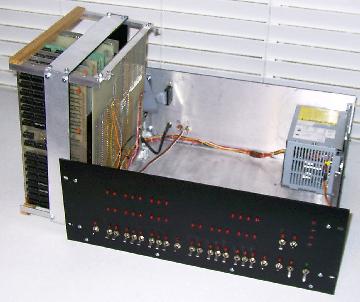
My 6800 system with flip up card cage.
|
|
Most of the software I wrote were very small programs that
performed specific tasks. I had scores of computer music compositions
that played from an AM radio placed near the processor. (Try that with
your PC!) I had my computer turning on lights, sounding alarms, and a
dozen other things. I wrote my own version of BASIC, and my own
"Star Trek" game. (You really didn't own a computer unless
you could play Star Trek!) All of my programming taught me something very important: I didn't
like programming. Oh, I received great satisfaction from seeing my
programs run as I had intended, but I knew that it wasn't what I
wanted to do for a living! I loved the hardware. I modified my system
constantly. I modified my 16x32 character video card to display 16x64,
added a hardware cursor and direct memory access, scrolling display
and a few graphic characters. About ten years ago I removed most of
those mods because the software drivers were lost and I had no desire
to rewrite them. I left the 64 character mod since changing the
software I had to support that was very easy. (You can see part of the
mod on the chip just above the crystal, in the photo of the 32x16
video card below. The visible mod is part of a clock doubler circuit.)
My system in the photo above is labeled a 6800, but in fact, I use
this system to test and run everything I am working on. The card cage
is hinged for easy access to the underside of the motherboard. My
original power supply was the 6 amp version. Not enough for a whole
lot. I replaced it in the mid eighties with one I robbed from a PC.
The one in the photo is a second replacement. Much smaller.
Dr. Robert Suding
In early 2004, I received an email from Dr. Robert Suding and an offer to meet
and talk about the Digital Group and the early days of personal computing. Dr.
Suding came to my house for lunch and conversation. With him, he brought the
Mini Bytemaster. We talked about all kinds of fun things, most of which Dr.
Suding has already written down and placed on his own web page: www.ultimatecharger.com/dg.html
Before leaving we made a deal for Mini Bytemaster. It took about an hour, and
the wives finally had to come in and break us up, but we did make a deal. : ) It
was a great time! We took a few pictures and waved goodbye. (Find my link at the
top of this page to see the Bytemaster.)
We then had the chance to get together again at the VCF 7.0 in November of
2004 and had a good time. Follow the link to see the pics!
|
|
|
|
![]()